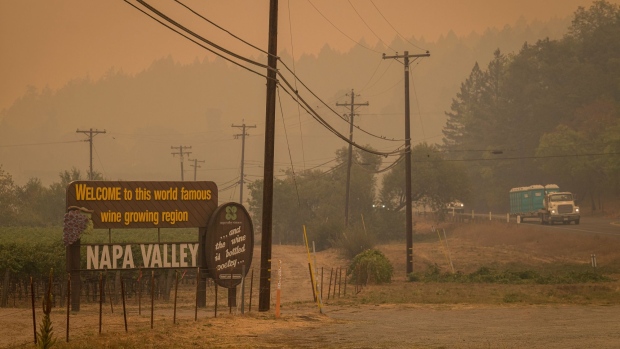Sep 30, 2020
California Firefighters Face Dire Forecast in Wine Country Blaze
, Bloomberg News

(Bloomberg) -- Even as firefighters in Northern California’s wine country battle a blaze that forced the evacuation of entire towns, a forecast of extreme heat and dry winds threatens to breath new life into the inferno.
The National Weather Service has issued a red flag warning for the area surrounding the Glass Fire, which has charred more than 48,000 acres and burned 80 homes since early Sunday. Wind gusts of 25-30 miles per hour were forecast for Thursday afternoon through Friday evening, raising the fire risk for the area. Temperatures in the city of Napa were forecast to hit 102 Thursday.
The blaze began as strong, dry winds raked the hills above Napa Valley, near the town of Calistoga, whose residents were ordered to evacuate. But in recent days, calmer and cooler weather helped slow the fire’s growth. Only 1,840 acres burned overnight Tuesday, and by Wednesday morning, firefighters had contained 2% of the blaze. The next wind event could stymie that progress.
“We’re looking at a very similar wind event as when this fire first started moving out,” said Incident Commander Billy See with the California Department of Forestry and Fire Protection, at a press conference Wednesday. “We’re preparing for the worst-case scenario, and we’re hoping for the best. So firefighters are going to be working around the clock securing those lines.”
The fire is raging northeast of Santa Rosa, an area devastated by the 2017 Tubbs Fire that was among the most destructive in California history. Properties damaged in the famed vineyard region included the Chateau Boswell estate, the Meadowood resort and the Castello di Amorosa winery.
California has been battered for weeks by rounds of extreme weather that state officials say have been fueled by climate change. Last month, a record-breaking heat wave triggered the state’s first rotating power outages since the 2001 energy crisis. More than 8,100 wildfires have burned a record 3.9 million acres this year, choking cities with smoke, killing at least 29 people and destroying more than 7,200 structures.
California’s peak wildfire season traditionally runs from September through November. It has grown longer and less predictable in recent years, with blazes coming as late as December.
©2020 Bloomberg L.P.


